The Apple Vision Pro's dystopian debut

Artificial intelligence has been the main attraction in the tech world lately. But Apple is shifting attention back to virtual reality with the Apple Vision Pro, its take on futuristic goggles that blur the lines between the digital and the physical. Did the much-ballyhooed debut launch without a hitch?
Background
Apple introduced the Vision Pro mixed-reality headset, with a starting price of $3,499, in June 2023 at Apple's Worldwide Developers Conference. During the unveiling, CEO Tim Cook called the product the "most advanced personal electronic device ever."
In a press release, Apple called the headset a "spatial computer" capable of merging digital media and the real world by combining virtual reality (VR) and augmented reality (AR). The Vision Pro has a customizable digital display that hovers over your surroundings. It can also display immersive virtual environments. Users can access apps, play games, FaceTime friends with a digitally rendered "persona" and watch video content. Users control the interface with their eyes, fingers and voice. The Vision Pro runs on visionOS, "the world's first spatial operating system," Apple said. Cook hailed the day as the "beginning of a new era for computing."
The latest
After eight months of hype and some skeptical early review, the Vision Pro officially dropped in the U.S. on Friday, Feb. 2. Customers who preordered the headset in January began receiving them or could pick them up at an Apple Store. The CEO appeared at the company's flagship Fifth Avenue store in New York City to celebrate the release. In reference to the steep price tag, Cook told CNBC's Jim Cramer the device was "tomorrow’s technology today." He said the company "priced it at the right level considering the value of it."
The headset debuted with over 600 available apps and games designed for the Vision Pro's unique capabilities. While mainstays like Netflix have yet to arrive, Disney+ has been available since day one, a testament to Disney's early support.
"Apple Vision Pro is unlocking the imaginations of our worldwide developer community, and we're inspired by the range of spatial experiences they've created for this exciting new platform," said Susan Prescott, Apple's vice president of Worldwide Developer Relations.
Meanwhile, videos of people wearing the headset in the wild have started appearing online since the product was released. Some of the most reckless offenders have posted videos wearing the Vision Pros in the driver's seat of a self-driving car. One such video of a driver in a Tesla Cybertruck pickup caught the attention of U.S. Secretary of Transportation Pete Buttigieg. "Reminder — ALL advanced driver assistance systems available today require the human driver to be in control and fully engaged in the driving task at all times," he said in a post on X, with the video attached. The driver in the video told Gizmodo the video was a skit.
The reaction
Critics have had a mixed reaction to the device. A common complaint from journalists and techies reviewing the device is that it can be uncomfortable to wear for extended periods. Some reported feeling nauseated, and many complained about how heavy it was. "There's nothing we could have done to make it lighter or smaller," Richard Howarth, Apple's vice president of industrial design, said to Vanity Fair in response to critics. Mike Rockwell, vice president of Apple's Vision Products Group, said the company "packed just about as much technology as you could possibly pack into that small of a form factor."
The problem with Apple's ambitions is the "technology to build a true optical AR display that works well enough to replace an everyday computer just isn't there yet," Nilay Patel said in The Verge. The company has "settled for building a headset with real-time video passthrough," which is the "defining tradeoff" of the device. "It is a VR headset masquerading as an AR headset," Patel said.
Apple wants the Vision Pro to be as "subtle and unobtrusive as pulling out an iPhone or a pair of AirPods," Kevin Roose said in The New York Times. "But that's not going to happen, at least not for a while." The Vision Pro is most impressive in a fully immersed VR environment, not the AR environment Apple has envisioned. "And while Apple has made it much easier to toggle between virtual and physical worlds, there's still some friction," Roose said.


